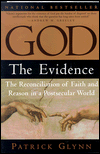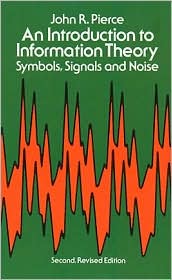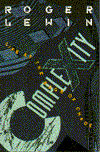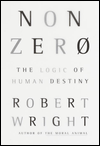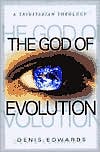 |
Michael
Shermer's
Why
Darwin
Matters |
Intelligent Design theory, or ID, is the version of creationism recently put forth by a cadre of credentialed scientists and others who say Darwin was wrong about evolution. In
Why Darwin Matters: The Case Against Intelligent Design, his latest book, Michael Shermer argues that it is ID that is wrong, for a whole host of reasons.
Shermer is the founding publisher of
Skeptic magazine and the executive director of the
Skeptics Society. His monthly column appears in
Scientific American. He is the author of other books about skepticism, which he says is basically the intellectual posture of "thoughtful inquiry." He calls science essentially a body of knowledge that is
testable. Science is thus "applied skepticism" (p. 48).
By those lights, he says ID theory is not science at all.
Why Darwin Matters catalogues the reasons why it fails the scientist's "six principles of skepticism" (pp. 48-53):
- Hume's Maxim, or, what is more likely?
- The Known and the Unknown, or, before you say something is out of this world, first make sure it is not in this world.
- Burden of Proof, or, extraordinary claims require extraordinary evidence.
- Either-Or Fallacy, or, disproving A does not prove B.
- The Fossil Fallacy, or, one datum does not a science make.
- Methodological Naturalism, or, no miracles allowed.
 |
Tim M.
Berra's
Evolution and
the Myth of
Creationism |
Because it is basically a debate-style rebuttal, Shermer's book does not provide the uninitiated with a broad overview of what Darwinism's claims are. (For that, try
Evolution and the Myth of Creationism, by Tim M. Berra.) It is, rather, an overview of
the case against the case against Darwin.
For example, ID proponents assail the large "gaps" that exist in the fossil record. By no means is every rung on evolution's ladder attested to by a known fossil, creationists charge (and evolutionists admit). When evolutionists unearth another ladder rung, partially filling a gap, creationists merely "respond that there are now
two gaps in the fossil record!" To this debating ploy Shermer cries foul (p. 51). This sort of pointed retort is a mainstay in Shermer's argumentation.
As I understand it, Darwin's theory of evolution, as updated by modern science, tells us that all biological species today — including
Homo sapiens — descend from other species. In the distant past, there came to be (in ways unspecified by Darwinism) the first simple kinds of organisms. These were, we now realize, the early bacteria. Over the first one billion years or so of life on earth (see p. 86), they evolved into various sorts of more internally complex, yet still single-celled, bacteria.
Then, 1.7 billion years ago, the first multicellular life appeared. 1.2 billion years ago, higher algae forms arrived. 650 million years ago, the primitive Ediacaran fauna came into the waters of the world. Finally, about 500 to 550 million years ago, in the Cambrian period, there was an explosion of complex multicellular life from which virtually all species today descend.
But how, Darwin asked,
could one species change into another? His answer: by descent with modification. Heritable factors unknown to Darwin (we now call them genes) can be modified slightly (by mutations and other processes) from generation to generation. These minor modifications can accumulate over time, making, eventually, a new species.
Accumulation over time only happens to the modifications that
help their possessors survive and reproduce under their particular environmental conditions. "Natural selection" ruthlessly weeds out the modifications that don't help, Darwin said. The ones that aren't weeded out — the ones that make for greater "fitness" — then get passed down through subsequent generations. To these original modifications are added, over the eons,
more fitness-inducing modifications as they happen by random chance.
If this transpires in a population that is in any way cut off from the rest of its kind — say, by a geographic barrier — the isolated population will eventually accumulate enough modifications that it cannot mate with its erstwhile kin, even if a reunion occurs. It will have become a new species.
Each externally observable minor modification en route to a new species could conceivably be preserved as an individual fossil. However, that's not likely. It's not even likely that every species in a given line of species-by-species descent has left a fossil. The ones that weren't fossilized constitute the permanent gaps, the rungs in the evolutionary ladder that we can never document.
Creationists long ago complained of those gaps. To their complaints, Intelligent Design proponents have now added a new wrinkle. They say that the ladder's rungs are not "missing links" at all. Rather, they were never there in the first place, because they
couldn't have existed in principle.
Looked at another way, ID says there
was in fact something of an "evolutionary ladder," in that more complex species did arrive on the scene well after earlier, simpler ones. The fossil record does not lie in this regard. It's just that the rungs on the ladder have sometimes been spaced much farther apart than evolution by natural selection could deal with alone.
Darwinian evolution, ID proponents say, in effect has short legs. It can manage to ascend a ladder with close-spaced rungs, corresponding metaphorically to minor "microevolutionary" changes within established species. But barriers exist, say IDers, which, when encountered, prevent natural selection's short leg span from going any further up the ladder of increasing complexity.
These barriers are ones of "irreducible complexity." Typically, the amount by which complexity increases in a new species, compared with its simpler ancestral one, is too great for unaided natural selection to manage, rung by rung. Or, if you will, at certain points on this imaginary ladder of increasing evolutionary complexity the rungs are spaced much too far apart.
That's where the Intelligent Designer comes in. Whether the Designer is God or some other supernatural or extraterrestrial intelligence, he, she, or it must have intervened to lift evolving species up to higher rungs of the complexity ladder too distant to be climbed to straightforwardly by natural selection alone.
Or so says ID theory. Well-known ID theorists such as Michael Behe point to various organs and functions of existing species — the propulsive flagellum of bacteria, the wing, the eye, human blood clotting — that supposedly had to arise all in one fell swoop. Missing just one component, each would be useless. But each component calls for a
separate Darwinian modification to be preserved by natural selection. How could such tiny step-by-step changes, accumulated over eons of time, make a wing?
By means of
exaptation, for one, Shermer writes:
... a feature that originally evolved for one purpose is [in exaptation] coopted for a different purpose. The incipient stages in wing evolution had uses other than for aerodynamic flight — half wings were not poorly developed wings, they were well-developed something elses — perhaps thermoregulating devices. The first feathers in the fossil record, for example, are hairlike and resemble the insulating down of modern bird chicks. Since modern birds probably descended from bipedal therapod dinosaurs, wings and feathers could have been employed for regulating heat — holding them close to the body would retain heat, stretching them out would release heat. (p. 69)
What about the idea broached by ID theorist William Dembski that there is "no free lunch"? During the course of evolution, what he calls "complex specified information" (CSI) has to have experienced jumps whose magnitude is more than nature's laws, augmented by chance, permit. Ergo, there must be a Designer.
The DNA in genes encodes huge numbers of bits of information. The number of bits that have to be added to a genome to produce an eye, says Dembski, is far too large to happen via the workings of natural law, or chance, or any combination of the two. Since the necessary new information is (by virtue of its "complexity") too improbable to happen at random, and since it is "specified" information (it achieves an independently statable goal, e.g., vision) an intelligent being must have furnished it.
Or, as Shermer summarizes the claim, Dembski's "Law of Conservation of Information says that natural causes such as chance and evolution cannot increase the complex specified information content of an organism by more than 500 bits of information" (p. 72). Dembski's law, if correct, might count as the Fourth Law of Thermodynamics.
But the law is not correct. Shermer finds it, rather, "abundantly clear that information in the natural world — through DNA, for example — is transferred and increased by natural processes" (p. 73).
For example, the earliest bacteria had no nuclei, mitochondria, etc. These organelles which higher organisms, us included, today inherit in their constituent cells arose when the earth's original bacteria took
other bacteria into themselves intact. When they did that, their genomes increased sharply in size and complexity.
In similar fashion, functions like human blood clotting arose when existing genes in an ancestral genome were
duplicated by some sort of copying mistake, and then the duplicates evolved new functions while the originals kept on doing what they did before (see pp. 73-74). The total amount of information in the genome typically went up with each gene duplication by more than Dembski's 500 bits. Dembski's law is accordingly wrong.
What of related claims that the
Second Law of Thermodynamics itself makes evolution impossible? That law says a closed, isolated system will inevitably "run down" into a chaos-like equilibrium over the course of time. This is entropy. But life on earth, seen as a thermodynamic system of energy and heat, has done just the opposite. Its order, complexity, and diversity have
increased.
Shermer points out (pp. 81-82) that this vision of an entropy-shackled biosphere is a straw man. The earth is not a closed, static system. It is open and dynamic, receiving external energy from the sun. Accordingly, it
... slips in and out of thermodynamic equilibrium. The sciences of nonlinear dynamics and of chaos and complexity theory show that [such] systems can spontaneously self-organize into more complex systems when they are in states of thermodynamic nonequilibrium. When a system is out of balance, energy flowing in and out of the system triggers the parts of the system to interact with one another locally, and these coupled interactions reverberate throughout the system to sustain it. Autocatalysis, or feedback loops within the system, can cause it to grow in complexity. From these self-organized autocatalytic interactions emerge complexity and order. All of this happens without any top-down input [as from an Intelligent Designer]. Evolution no more breaks the Second Law of Thermodynamics than one breaks the law of gravity by leaping into the air. (p. 82)
Shermer gives many dozens of such refutations of Intelligent Design theory in his book. He complements this material with discussions of how true science works, and how multiple avenues of scientific inquiry have together established the factuality of Darwin's theory of evolution beyond all reasonable doubt. Yet, he grouses, national polls show nearly half of Americans still don't believe in Darwin.
His chapters on "Why People Do Not Accept Evolution" and "In Search of the Designer" attempt to say why: people resist science in general; they object when science undermines religious tenets; they fear that being "descended from apes" degrades our humainty, ushering in moral degeneracy and nihilism; and (from the liberal side) they hate it that evolutionary theory seemingly sets limits on how far we humans can progress.
Based on polling he and a coworker have done, Shermer also finds that we who believe in God typically are thought to do so for "emotion-based" and "fear-averse" reasons, even by fellow believers (see pp. 36-38). There are intellectually based reasons for believing in God — seeing the world as exquisitely designed, for example — but those who were polled tended to attribute such rational motives to
themselves and the emotion-based motives to others.
Not surprisingly, Shermer sees this "intellectual attribution bias" as evidence that we humans have evolved in such a way as to be prone to such a bias. "We are pattern-seeking as well as pattern-finding animals," the author notes (p. 38). We look for and expect design, even where it patently doesn't exist. When we think we find it, we assume a designer. We assimilate that expectation to our understanding of God.
But, Shermer argues (pp. 40-42), using logic one may find a bit strained, even if life on earth
is designed, it could just as well be the handiwork of an advanced extraterrestrial intelligence. Why God, necessarily?
It is at this point in his exposition that he ventures boldly into theology. Though Shermer says he spent several years of his youth as an evangelical Christian and a creationist, he apparently no longer believes in the sort of God who would intervene in natural processes.
Echoing the American Protestant neo-orthodox theologian
Langdon Gilkey, Shermer says (p. 43), "Far from being a mere intelligent watchmaker, God is the 'transcendent source of all existence' who creates
ex nihilo — from nothing." And, per German Protestant theologian
Paul Tillich: "God does not exist. He is being itself beyond essence and existence ... ."
And so:
If we think of God as a thing, a being that exists in space and time, it constrains God to our world, a world of other things and other beings that are also restrained by the laws of nature and the contingencies of chance. But if God is the maker of all things and all beings visible and invisible in heaven or earth, God must be above such restraints ... "The question of the existence of God can be neither asked nore answered," Tillich explains. "If asked, it is a question about that which by its very nature is above existence ... "
If there is a God, the avenue to Him is not through science and reason, but through faith and revelation. If there is a God, He will be so wholly Other that no science can reach Him ... .
Shermer could have left out the theology, maybe. He cites Gilkey and Tillich, thinkers noted for stressing the "otherness" of God at the expense of his approachability through Christ, the Church, and the sacraments. This is a basically Protestant view that has its merits and demerits. Catholics such as myself may well find it problematic. And what of Jews, Muslims, and members of non-monotheist religious traditions?
The neo-orthodox theological approach appeals to its proponents on the basis of such concepts as existential anguish, or the fear of non-being. But Shermer has made it clear that he
dislikes such "emotional" justifications for believing in God. Thus it would seem he is being inconsistent.
What's more, his foray into theology really has no part in his argument for Darwin. Darwin is right on the merits of the case, whether or not one believes in God. He is right whether one, if a theist, embraces Protestant neo-orthodoxy or not. The scientific rightness of evolution theory is the main thrust of Shermer's argument, and he makes the argument well.
His epilogue to his argument — and to his book — makes a welcome spiritual, as opposed to theological, point. "There are many ways to be spiritual," Shermer writes, "and science is one in its awe-inspiring account of who we are and where we came from."
He embellishes the subject of the spirituality of science by citing the late astronomer and
Cosmos host
Carl Sagan:
The universe is all there is, or ever was, or ever will be ...
Our contemplations of the cosmos stir us. There's a tingling in the spine, a catch in the voice, a faint sensation as if a distant memory of falling from a great height. We know we are approaching the grandest of mysteries ...
The cosmos is within us. we are made of star stuff ... We've begun at last to wonder about our origins, star stuff contemplating the stars, organized collections of ten billion billion billion atoms contemplating the evolution of matter, tracing that long path by which it arrived at consciousness here on the planet Earth and perhaps throughout the cosmos. Our obligation to survive and flourish is owed not just to ourselves but also to that cosmos, ancient and vast, from which we spring. (pp. 157-158)
"That is spiritual gold, and Carl Sagan was one of the most spiritual scientists of our epoch," Shermer writes. Then he continues, "How can we find spiritual meaning in a scientific worldview? Spirituality is a way of being in the world, a sense of one's place in the cosmos, a relationship to that which extends beyond oneself."
In an endnote, Shermer extends his lionizing of Sagan's scientific spirituality by quoting the final passage from the astronomer's sci-fi novel
Contact. I find the passage itself somewhat inscrutable, so I'll quote
Wikipedia's interpretation:
In a kind of postscript, Ellie [Arroway, the novel's protagonist], acting upon a suggestion by the [extraterrestrial] senders of the Message, works on a program which computes the digits of π to record lengths and in different bases. Very, very far from the decimal point (10^20) and in base 11 (postulated number of dimensions in M theory, after 1995), it finds that a special pattern does exist when the numbers stop varying randomly and start producing 1's and 0's in a very long string. The string's length is the product of 11 prime numbers. The 1's and 0's when organized as a square of specific dimensions form a perfect circle.
You can argue (the Wikipedia article shows how) that there is actually no "message from God" in π, which is the ratio of the circumference of any circle to its diameter. It's not clear whether there's "hidden meaning" of any sort in a numerical expansion of that number's digits. (I myself am not even clear: does Ellie Arroway's expansion actually yield the stated results, or is this just a literary device on Sagan's part?) But I think such niggling misses the point.
The point is more along the lines of the human need to, as Shermer says, be in fruitful, spiritual relationship with "that which extends beyond oneself." Ellie Arroway finds such a relationship by, in effect, being
in dialogue with the cosmos. She looks for and receives a message from afar. She decodes the message. She finds a hidden, universal meaning. In that dialogue itself she encounters what she was looking for all along, as a human person.
The important thing spiritually is not in the fact of the π pattern (if it exists). It is rather in the experience of the dialogue. Science is a way to have a true spiritual encounter with "all there is, or ever was, or ever will be." In the words of
Martin Buber in
I and Thou, it is yet another way to "speak the primary word
I–Thou."


